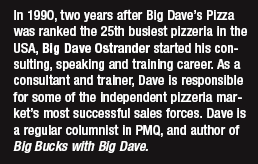Another year has come and gone. How did you do? Did you meet most of your goals and objectives? Did you have any goals and objectives except making a living and showing a profit? Did the cheese price spike of last spring hit your bottom line hard?
May I share a few thoughts that helped me give myself an annual report card? I certainly don’t profess to be an “A” student, but have picked up a few tricks to keep moving in the right direction.
I consulted for a major food service distributor for 13 years. I was astonished to learn they had a 5-10-15 and 20-year business plan. This time line was the result of a dozen ‘wise men’ spending a week in isolation at a working retreat. That’s how I was hired. They decided the company was ready to actively and aggressively sell to pizzerias. Then they designed the – here comes the scary words – action plan. An action plan is really a very simple model.
Draw a circle on the top of a sheet of paper and another at the bottom. Connect them with a line. In the bottom circle write, “Now.” And in the top circle write a specific date, such as May 1st, 2005. Then think of a specific goal you must have done by that date. It may be a business or personal goal.
Hypothetically, let’s say your goal is to reduce foodcost by 5 percent. That goes at the top of the page. You say to yourself, “By May 1, 2005, I will have reduced my foodcost by a minimum of 5 percent.”
What are some things you can do to accomplish that goal? These tactics become tick marks on the time line connecting the two circles.
Accomplishing this big task is nothing more than breaking down the big job into small bite size tasks. The tactics I would have on my action plan would be something like this:
- Study Prime Vendor Agreements and prepare a letter of intent for your suppliers to respond to. This letter spells out your desire to choose a supplier that will sell you 90 percent of your food and supply needs on a audited cost plus basis. Prime vendor agreements on their own have shown repeatedly that your weekly food bill will be reduced at least 3 percent. That’s why all of the really profitable / successful restaurant chains in the country have them in place.
- Perform an in-depth menu entrée costing study. This will identify the real food cost of every pizza, salad, pasta, wing and beverage offering on your menu. This task is really sped up with a few basic tools. A good digital scale and portion control devices such as spoodles and cups will help tremendously. Once the ingredients have been weighed out they need to be updateable because of fluctuating food ingredient pricing. You may choose to post the data on a sheet of lined paper, with pencil and calculator, transfer it to a computerized spreadsheet or use my pizza specific, costing software program – FoodCost Pro. Either way you choose will give you a real cost per menu item. Some will be low, some average and others high. I’ve seen quite a few 60 percent and 70 percent items this year. The all-time record was set a few weeks ago in Charlotte, North Carolina. A brand new client of mine was running a coupon with a 117 percent food cost and didn’t know it. I really don’t care what your food cost is within reason. Obviously the 117 percent’er was history.
- The most important number a comprehensive study will disclose is the items’ contribution margin – CM. This dollar amount is the money you have left over after you pay for the food. This dollar amount –CM, is what you deposit in the bank that pays all of the bills and ends up on the bottom line of your P&L Statement. My banker never once complimented me on my awesome food cost. He only deals in money, and so should you. Once these weights are established the next step is create a printed topping cheat sheet and place it eye level on your make line. You can never obtain, sustain and reduce foodcost if you don’t know how much every item on your menu cost to manufacturer. If you are free throwing toppings, you’re doomed to repeat erratic food cost peaks and valleys. A small investment in a few tools will make a world of difference in your profitability.
- Once exact food cost and CM has been established the next step is to Menu Engineer your menu. Which pizza generates the most CM in a month’s time for your shop? Which contributes the least? The exercise will scientifically show you which items on your menu are the most profitable and most popular and how to place them on your menu or flier. Your menu should be a marketing tool rather than a decorative pricelist, driving sales to the most popular and profitable items you sell.
- I would improve my ordering and receiving procedures. I would eliminate all over ordering and run a lean inventory level.
- I’d analyze my prep functions.
- I’d install a video surveillance system.
- I’d create an accurate inventory system that price extends my food inventory into dollars quickly. You are just guessing at food cost if you don’t have a beginning and ending monthly inventory in dollars. Inaccurate ending inventory means a dollar for dollar misstatement of your actual food cost.
- I’d start accounting for burned, wasted, complimentary and employee meals.
- I’d know what my coupons and special deals cost and net and price them accordingly. Perception of value is more powerful than reality.

The key to any marketing, promotion or action plan is execution. Determine what you need to focus on and make your list and check it twice. Now that you have your tasks spelled out, place them on a reasonable time line. Some tasks can be finished in a day and some will take longer, but create a list and start checking items off. The way to achieve inner peace is to finish all the things you have started, so commit yourself to addressing everything on the list.













